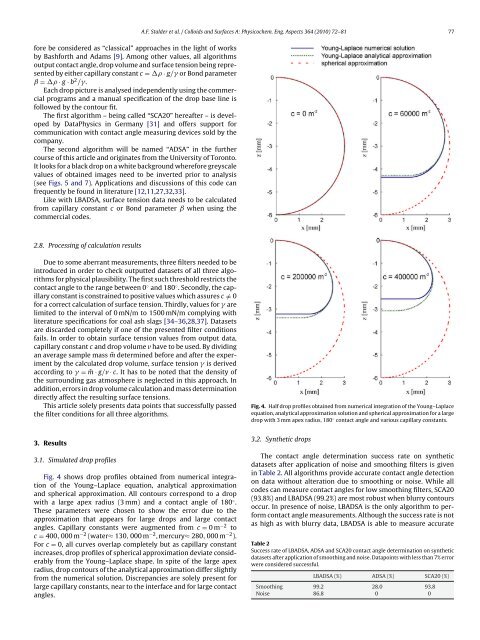Low-bond axisymmetric drop shape analysis for surface tension ...
Low-bond axisymmetric drop shape analysis for surface tension ...
Low-bond axisymmetric drop shape analysis for surface tension ...
Create successful ePaper yourself
Turn your PDF publications into a flip-book with our unique Google optimized e-Paper software.
A.F. Stalder et al. / Colloids and Surfaces A: Physicochem. Eng. Aspects 364 (2010) 72–81 77<br />
<strong>for</strong>e be considered as “classical” approaches in the light of works<br />
by Bash<strong>for</strong>th and Adams [9]. Among other values, all algorithms<br />
output contact angle, <strong>drop</strong> volume and <strong>surface</strong> <strong>tension</strong> being represented<br />
by either capillary constant c = · g/ or Bond parameter<br />
ˇ = · g · b 2 /.<br />
Each <strong>drop</strong> picture is analysed independently using the commercial<br />
programs and a manual specification of the <strong>drop</strong> base line is<br />
followed by the contour fit.<br />
The first algorithm – being called “SCA20” hereafter – is developed<br />
by DataPhysics in Germany [31] and offers support <strong>for</strong><br />
communication with contact angle measuring devices sold by the<br />
company.<br />
The second algorithm will be named “ADSA” in the further<br />
course of this article and originates from the University of Toronto.<br />
It looks <strong>for</strong> a black <strong>drop</strong> on a white background where<strong>for</strong>e greyscale<br />
values of obtained images need to be inverted prior to <strong>analysis</strong><br />
(see Figs. 5 and 7). Applications and discussions of this code can<br />
frequently be found in literature [12,11,27,32,33].<br />
Like with LBADSA, <strong>surface</strong> <strong>tension</strong> data needs to be calculated<br />
from capillary constant c or Bond parameter ˇ when using the<br />
commercial codes.<br />
2.8. Processing of calculation results<br />
Due to some aberrant measurements, three filters needed to be<br />
introduced in order to check outputted datasets of all three algorithms<br />
<strong>for</strong> physical plausibility. The first such threshold restricts the<br />
contact angle to the range between 0 ◦ and 180 ◦ . Secondly, the capillary<br />
constant is constrained to positive values which assures c /= 0<br />
<strong>for</strong> a correct calculation of <strong>surface</strong> <strong>tension</strong>. Thirdly, values <strong>for</strong> are<br />
limited to the interval of 0 mN/m to 1500 mN/m complying with<br />
literature specifications <strong>for</strong> coal ash slags [34–36,28,37]. Datasets<br />
are discarded completely if one of the presented filter conditions<br />
fails. In order to obtain <strong>surface</strong> <strong>tension</strong> values from output data,<br />
capillary constant c and <strong>drop</strong> volume v have to be used. By dividing<br />
an average sample mass ¯m determined be<strong>for</strong>e and after the experiment<br />
by the calculated <strong>drop</strong> volume, <strong>surface</strong> <strong>tension</strong> is derived<br />
according to = ¯m · g/v · c. It has to be noted that the density of<br />
the surrounding gas atmosphere is neglected in this approach. In<br />
addition, errors in <strong>drop</strong> volume calculation and mass determination<br />
directly affect the resulting <strong>surface</strong> <strong>tension</strong>s.<br />
This article solely presents data points that successfully passed<br />
the filter conditions <strong>for</strong> all three algorithms.<br />
Fig. 4. Half <strong>drop</strong> profiles obtained from numerical integration of the Young–Laplace<br />
equation, analytical approximation solution and spherical approximation <strong>for</strong> a large<br />
<strong>drop</strong> with 3 mm apex radius, 180 ◦ contact angle and various capillary constants.<br />
3. Results<br />
3.1. Simulated <strong>drop</strong> profiles<br />
Fig. 4 shows <strong>drop</strong> profiles obtained from numerical integration<br />
of the Young–Laplace equation, analytical approximation<br />
and spherical approximation. All contours correspond to a <strong>drop</strong><br />
with a large apex radius (3 mm) and a contact angle of 180 ◦ .<br />
These parameters were chosen to show the error due to the<br />
approximation that appears <strong>for</strong> large <strong>drop</strong>s and large contact<br />
angles. Capillary constants were augmented from c = 0m −2 to<br />
c = 400, 000 m −2 (water≈ 130, 000 m −2 , mercury≈ 280, 000 m −2 ).<br />
For c = 0, all curves overlap completely but as capillary constant<br />
increases, <strong>drop</strong> profiles of spherical approximation deviate considerably<br />
from the Young–Laplace <strong>shape</strong>. In spite of the large apex<br />
radius, <strong>drop</strong> contours of the analytical approximation differ slightly<br />
from the numerical solution. Discrepancies are solely present <strong>for</strong><br />
large capillary constants, near to the interface and <strong>for</strong> large contact<br />
angles.<br />
3.2. Synthetic <strong>drop</strong>s<br />
The contact angle determination success rate on synthetic<br />
datasets after application of noise and smoothing filters is given<br />
in Table 2. All algorithms provide accurate contact angle detection<br />
on data without alteration due to smoothing or noise. While all<br />
codes can measure contact angles <strong>for</strong> low smoothing filters, SCA20<br />
(93.8%) and LBADSA (99.2%) are most robust when blurry contours<br />
occur. In presence of noise, LBADSA is the only algorithm to per<strong>for</strong>m<br />
contact angle measurements. Although the success rate is not<br />
as high as with blurry data, LBADSA is able to measure accurate<br />
Table 2<br />
Success rate of LBADSA, ADSA and SCA20 contact angle determination on synthetic<br />
datasets after application of smoothing and noise. Datapoints with less than 7% error<br />
were considered successful.<br />
LBADSA (%) ADSA (%) SCA20 (%)<br />
Smoothing 99.2 28.0 93.8<br />
Noise 86.8 0 0
















